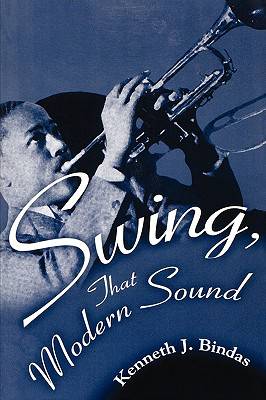
- Afhalen na 1 uur in een winkel met voorraad
- Gratis thuislevering in België vanaf € 30
- Ruim aanbod met 7 miljoen producten
- Afhalen na 1 uur in een winkel met voorraad
- Gratis thuislevering in België vanaf € 30
- Ruim aanbod met 7 miljoen producten
Omschrijving
Swing, That Modern Sound by Kenneth J. Bindas How America invented swing, how swing energized America. It was for stage bands, for dancing, and for a jiving mood of letting go. Throughout the nation swing resounded with the spirit of good times. The swing era was America's segue into modernity. But this pop genre, for a decade America's favorite, arose during the worst of times, the Great Depression. From its peak in the 1930s until bebop, rhythm and blues, and country swamped it after World War II, swing defined an American generation and measured America's musical heartbeat. In its heyday swing reached a mass audience of very disparate individuals and united them. They perceived in the tempers and tempos of swing the very definition of modernity. What fed the music? And, in turn, what did the music feed? What social structures encouraged swing's creation, acceptance, and popularity? Swing, That Modern Sound analyzes the cultural and historical significance of swing and tells how and why swing achieved its audience, unified its fans, defined its generation, and, after World War II, fell into decline. As it examines the role of race, class, and gender in the creation of this music, Swing, That Modern Sound tells how the genre came to symbolize the modernist revolution taking place in America. Kenneth J. Bindas is an associate professor of history at Kent State University, Trumbull Campus, in Warren, Ohio. He is the author of All of This Music Belongs to the Nation: The WPA's Federal Music Project and American Society, 1935-1939.
Specificaties
Betrokkenen
- Auteur(s):
- Uitgeverij:
Inhoud
- Aantal bladzijden:
- 232
- Taal:
- Engels
Eigenschappen
- Productcode (EAN):
- 9781578063833
- Verschijningsdatum:
- 21/08/2001
- Uitvoering:
- Paperback
- Formaat:
- Trade paperback (VS)
- Afmetingen:
- 151 mm x 229 mm
- Gewicht:
- 371 g

Alleen bij Standaard Boekhandel
+ 84 punten op je klantenkaart van Standaard Boekhandel
Beoordelingen
We publiceren alleen reviews die voldoen aan de voorwaarden voor reviews. Bekijk onze voorwaarden voor reviews.









